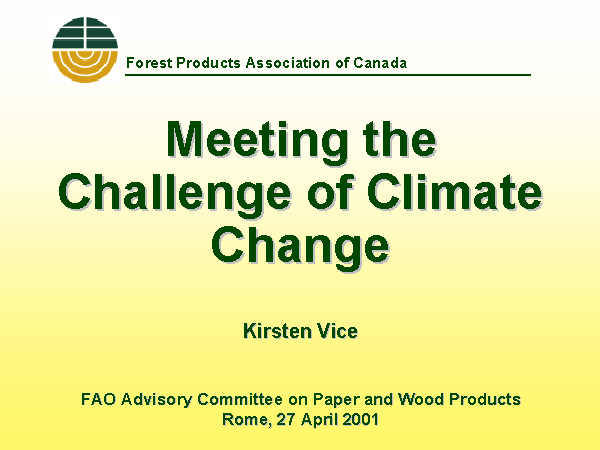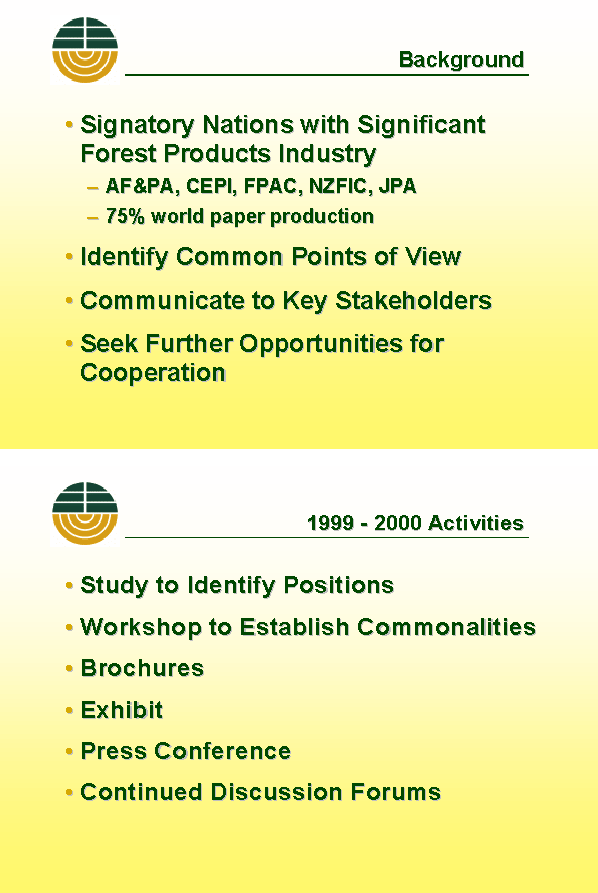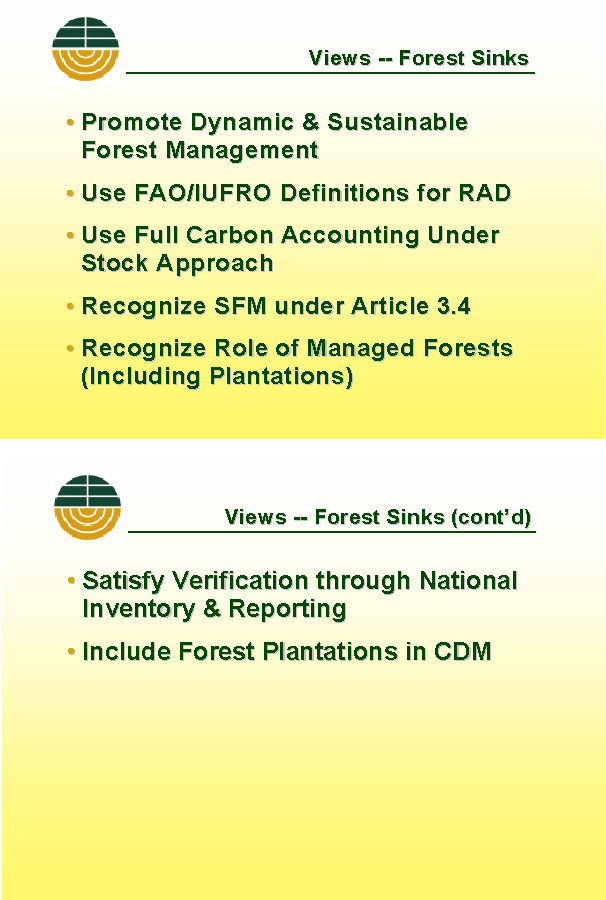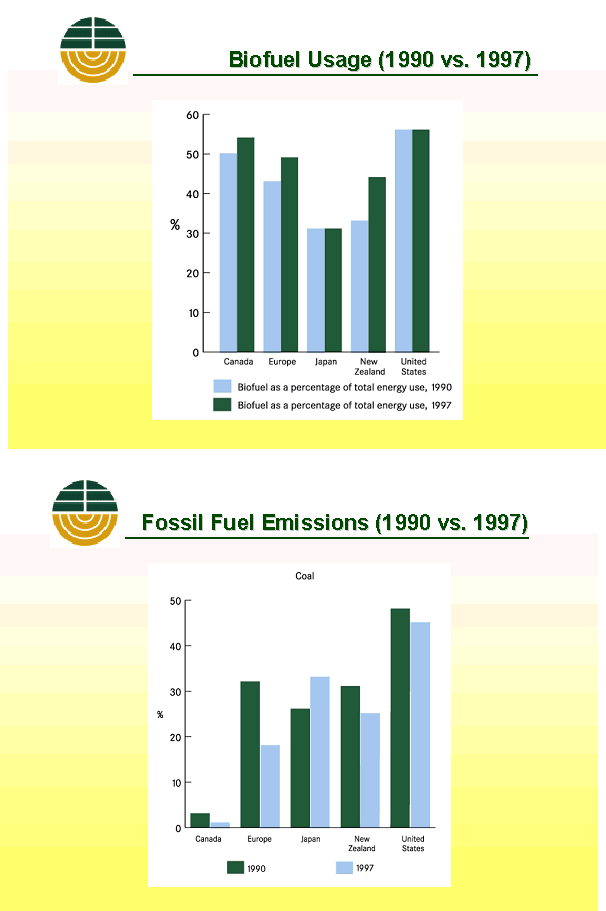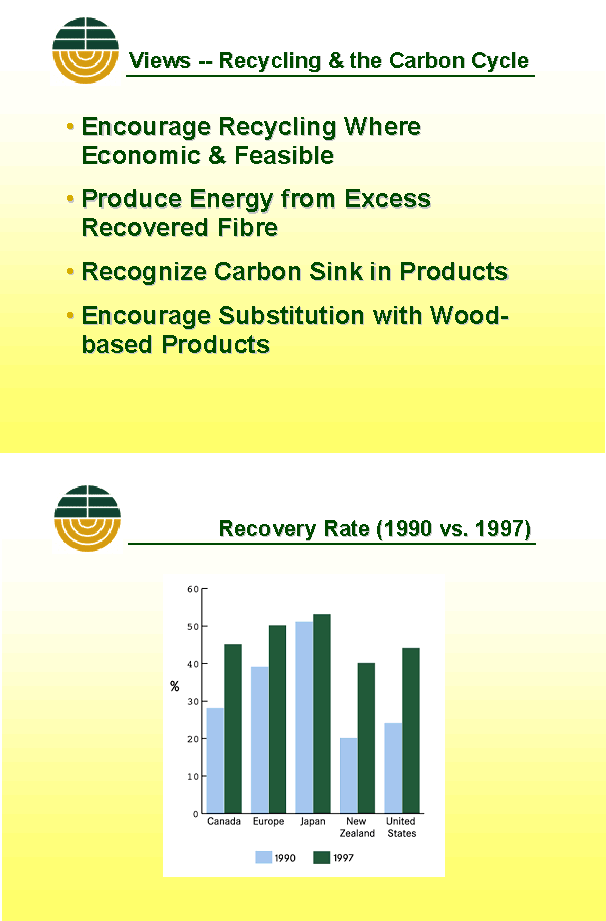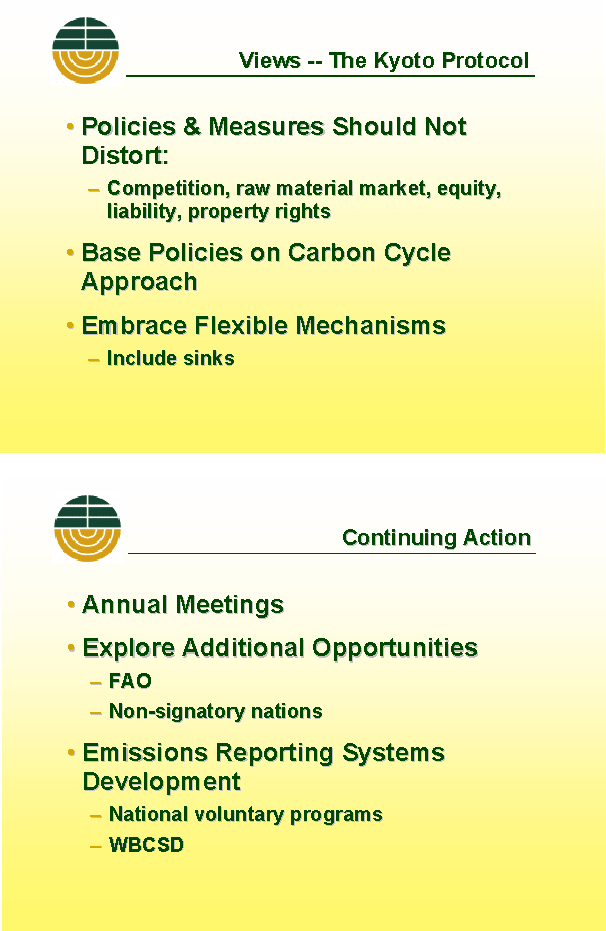


WULF KILLMANN
Food and Agriculture Organization of the United Nations
The third Conference of Parties to the United Nations Framework Convention on Climate Change (UNFCCC), held in Kyoto, Japan, in December 1997, adopted for the operationalization of the convention by consensus a legally binding commitment, the so-called "Kyoto Protocol" (KP). Its salient points are:
Thirty-nine developed countries and countries with economies in transition (Annex B countries) committed themselves to reduce GHG emissions, between 2008 and 2012, by overall at least 5 percent compared to the 1990 levels. The emission cuts would range from -8 percent for most European and some other countries to +10 percent for Iceland. Within the EU, a redistribution of the overall target amongst its member countries would be permitted, this redistribution scheme being called "bubble". Some countries, e.g. Germany, have additionally committed themselves to reduce greenhouse gas (GHG) emissions within 2005 by 25 percent compared to the 1990 figures.
Three "flexible mechanisms" for the mitigation of climate change were agreed upon:
- trading with quantified emission limitations and
reduction obligations (QUELRO), between Annex I countries;
- Joint
Implementation (JI) of emission reduction projects between Annex I countries;
and
- the Clean Development Mechanism (CDM), between Annex I countries and those not included in Annex I.
The Kyoto Protocol would enter into force when at least 55 Parties to the Convention had ratified it, including Annex I countries, accounting for at least 55 percent of total carbon dioxide emissions in 1990. By January 2001, the KP had been ratified by 33 Parties (out of a total of 84), with only one Annex I country (Romania), representing 1.2 percent of the required emission that would bring the Protocol into force.
Forests act as reservoirs by storing carbon in biomass and soils. They act as carbon sinks when their area or productivity is increased, resulting in greater uptake of atmospheric CO2. Conversely, they act as a source of GHGs when biomass burns or decays. Changes in land use (primarily deforestation in tropical areas) are currently the source of about 20 percent of global anthropogenic CO2 emissions.
Various forestry practices play a significant role in helping to slow down the accumulation of CO2 in the atmosphere: conservation management, storage management and substitution management.
The quantification of forests' contribution to emission reductions would require a comprehensive accounting of the associated carbon sources and sinks over time and a comprehensive analysis of other environmental and socio-economic criteria that influence forest management choices.
The Intergovernmental Panel on Climate Change (IPCC) estimates that, between 1995 and 2050, global carbon sequestration from reduced deforestation, forest regeneration and increased development of plantations and agroforestry could correspond to 12-15 percent of the amount of carbon emissions from fossil fuels.
While the UNFCCC mentions forestry only briefly, the Kyoto Protocol deals explicitly with forestry. Article 2 mentions that Annex I parties shall implement and/or further elaborate policies and measures such as ... promotion of sustainable forest management practices, afforestation and reforestation.
Other aspects in the KP of relevance to the forestry community and to FAO member countries are the sections on Afforestation, Deforestation and Reforestation (Article 3.3); on sources and sinks, including soil and biomass storage (Article 3.4) and their estimation (Article 5); on trade in emission reduction units (Article 6), annual reporting (Article 7), review and control mechanisms (Article 8); on improved methodologies to assess emissions and sinks (Article 10); and especially the CDM, which is described in Article 12.
The double purpose of the CDM is to assist developing Parties in achieving sustainable development and developed Parties to achieve compliance with their emission limitations and reduction commitments. The CDM will allow Annex I parties and Non-annex I parties to implement jointly projects which will result in certified emission limitations. This mechanism complements the tradable permits approach between Annex I parties.
The details of CDM implementation are still being debated, in particular regarding fossil fuel substitution by biofuels and the admissibility of forest and soil carbon pools as sinks.
The Special Report on Land Use, Land-use Change and Forestry, submitted by IPCC to the Parties at the twelfth session of the Subsidiary Body of Scientific and Technical Advice (SBSTA) in June 2000 in Bonn helped to cast more light on the role and potential of forests within the international mechanisms related to climate change.
At the sixth conference of Parties to the UNFCCC, Parties negotiated the basis for the Kyoto Protocol to become ratifiable. Parties did not succeed in agreeing on a common ground. The major issues on which opinions differed were all closely interlinked. They were:
The question of how compliance of Parties to signed agreements could be monitored and enforced remained unresolved. There was no agreement on the development of an international regime to enforce compliance.
A number of issues in relation to the flexible mechanisms remained unresolved, in particular in relation to the CDM. Parties could not agree on which projects to include or exclude under CDM, and if there should be a positive list. Neither could they agree on the development of rules and modalities for emission trading.
A fervent discussion circled round the question of to what extent certified emission reductions, accrued from projects under the flexible mechanisms, would supplement emission reductions achieved at the domestic source. Some Parties argued that the primary objective of the KP was to reduce emission reductions at the source, and that any reduction accrued under any of the three mechanisms should only supplement these.
Hotly debated was also how much credit a country could get for its land use and forestry practices. While some Parties argued that, without the acknowledgement of these practices and the wide inclusion of domestic sinks from LULUCF they would have never signed the KP in the first place, other Parties and NGOs feared that the sink approach would create a loophole, undercutting the integrity and original concept of the Kyoto Protocol as a measure to reduce domestic emissions from fossil fuel combustion in industry, energy production and transport.
The Kyoto Protocol promises the transfer of technologies to developing countries to help them adapt to climate change and to develop capacities dealing with the challenges and opportunities resulting from global warming and the international regimes such as the Convention and the KP. It remained unclear where the necessary funds would come from, who would pay, who would benefit, if they would be additional to international development aid, and what role international funding mechanisms such as GEF would play.
The duration period of carbon stocks in soils and biomass was discussed, as was the stability of these pools.
Many technical and administrative issues were partly discussed and still remained open, such as carbon accounting systems; verification and certification of communications; monitoring, evaluation, etc.; definitions for terms like forests, afforestation, reforestation, deforestation and others.
After the negotiations in The Hague had stalled, a series of hectic meetings between the major contenders in the discussions, in particular representatives of the Umbrella Group, G77 and the EU, ensued. It was agreed that the negotiations stalled at CoP6 would be resumed at the next meeting of the Subsidiary Bodies to the Convention (Subsidiary Body for Scientific and Technological Advice - SBSTA, and Subsidiary Body for Implementation - SBI) in Bonn, Germany. On request of the United States, the next meeting was shifted from May/June to 16-27 July 2001.
The world community will have to address the issue of global warming speedily, since it is on the rise and seems to threaten people and their livelihoods on this planet even more than anticipated, as the Intergovernmental Panel on Climate Change (IPCC) has reported in its Third Assessment Report, presented in January 2001 in Shanghai.
REVIEW OF FAO ACTIVITIES RELATED TO CLIMATE CHANGE
WULF KILLMANN
Food and Agriculture Organization of the United Nations
FAO established an Interdepartmental Working Group on Climate in Relation to Agriculture and Food Security as early as 1988. The Organization's activities related to climate issues are coordinated by, and executed under, the auspices of this working group. The Forestry Department then created a task force on forestry and carbon sequestration in order to coordinate its special forestry and climate activities.
The role of FAO in the context of climate change can be described as follows:
- neutral forum;
- repository and provision of data
and information (collation, analysis, dissemination);
- networking;
-
custodian of methods, standards and models;
- capacity building.
A wide range of activities in relation to climate change have been started or are ongoing. In the following they are grouped in accordance to one of the above-mentioned roles.
- Organization (jointly with the Central American Commission for Environment and Development - CCAD) of the Regional Meeting on the Contribution of Forests to the Mitigation of Climate Change (Tegucigalpa, Honduras, 4-6 October 1999).
- Organization (jointly with the Inter-American Development Bank) of the Latin American Meeting on Forests and their Contribution to the Mitigation of Climate Change (Santa Cruz de la Sierra, Bolivia, 14-15 August 2000).
- Organization (jointly with the Environment and Natural Resources Service of FAO (SDRN) of the Workshop on Verification of Country-Level Carbon Stocks and Exchanges in Non-Annex I Countries (Rome, 27-29 September 2000).
- Assessment of methods and tools to improve the sustainability of forest, crop and animal production systems and their resilience against climate change. This includes, in particular, conservation agriculture.
- Forestry data (Forest Resources Assessment - FRA 2000) and land use data. They include both actual land use (AfriCover and a number of detailed country studies) and potential land use in the ambit of the Agroecological Zones (AEZ) approach.
- Forestry, crop, animal and farm inputs, production data and planted areas as proxies of agricultural sources of CO2 (from land use change), methane (from rice paddies and ruminants) and nitrous oxide (from fertilizer use).
- Soil maps as proxies of soil carbon.
- Publications:
- El Protocolo de Kyoto y el Mecanismo para un Desarrollo Limpio (1999);
- Climate change and the forestry sector: Possible legislative responses for national and sub-national governments;
- The potential of instruments related to the UN Framework Convention on Climate Change for Forestry in Africa (prepared with CIRAD-ForÍt and to be published in September/October 2001);
- Manual on integrated soil management and conservation practices (FAO Land and Water Bulletin No. 8);
- Conservation Agriculture - Code: 214A6 Matching production with sustainability;
- Various publications of the Sustainable Development and Forestry Departments of FAO on the use of bioenergy, for instance Wood energy, climate and health, international expert consultation (Field Document No. 58, 2000);
- Various economic papers such as Two essays on climate change and agriculture - A developing country perspective (FAO Economic and Social Development Paper No. 145).
- Participation in the Global Terrestrial Carbon Observation (TCO) initiative to respond to the need by the policy and scientific communities for improved knowledge of the role of terrestrial carbon sources and sinks. It aims to provide information on the spatial and temporal distribution of carbon sources and sinks in the terrestrial biosphere using data obtained through systematic ground- and satellite-based observations. Other partners include, next to FAO, IGBP, CEOS, etc.
- Participation in major meetings like UNFCCC Subsidiary Body on Science and Technology Advice and the Conference of the Parties.
- Participation in IPCC (Inter-governmental Panel on Climate Changes) technical meetings and technical review of the different working group contributions to the Special Reports on Land Use, Land-Use Change and Forestry (SR-LULUCF), the SR on technology transfer and the SR on emission scenarios, as well as the Third Assessment Report (TAR) Working Group I (scientific basis), II (mitigation) and III (impacts, adaptation and vulnerability).
- Participation of the Agriculture Department of FAO in various meetings and activities on carbon sequestration in soil, for instance the FAO/IFAD (International Fund for Agricultural Development) Meeting on the Prevention of Land Degradation, Enhancement of Carbon Sequestration and Conservation of Biodiversity or the Meeting on Carbon Sequestration Options under the Clean Development Mechanism (CDM) to Address Land Degradation. The work on conservation agriculture is also very important.
- Co-sponsoring (together with the Centre for International Forestry Research - CIFOR) of the Workshop on Research Needs on Forestry and Climate Change after CoP6 in Bogor, Indonesia, 6-8 March 2001.
- Establishment of an electronic list server (CLIM-FO-L) to share information and experiences.
- Contribution on forestry definitions to the Intergovernmental Panel on Climate Change (IPCC) meeting on the preparation of the draft outlines of the IPCC SR on LULUCF (23-24 September 1998).
- Forestry definitions (FRA Working Paper No. 33, 2000).
The recruitment process of a Senior Forestry Officer (Forests and Climate Change) in the Forest Products Division is under way. This will notably improve the capacity of the Organization to respond to the challenges deriving from the international climate negotiations in the ambit of UNFCCC.
As from the next biennium (2002-2003), the Organization has established Priority Areas for Interdepartmental Action (PAIAs). One of them deals with climate change and some divisions have allotted funds to climate change activities.
In the FAO Committees on Agriculture (COAG) and Forestry (COFO) 2001, member countries have been requested to give guidance on the level of FAO's involvement in international climate activities. Strong support and a comprehensive climate programme for FAO are anticipated to derive from these discussions.
FAO's future activities on climate change will be aimed to:
- coordinate the activities within FAO under the Interdepartmental Working Group (IDWG) on climate;
- develop a more comprehensive climate change programme for the Organization, intended mainly to assist member countries in reducing emissions and adapting to climate changes;
- assist member countries in understanding the science of carbon sequestration and climate change and the debates on the subject;
- assist member countries in preparing legal, policy and regulatory instruments to support their strategies and commitments to international protocols;
- assist member countries in strengthening institutional frameworks and building capacity to implement strategies;
- assist member countries in monitoring their performance with respect to international obligations;
- assist member countries, through the Forest Resources Assessment (FRA), in assessing forest biomass densities and areas and providing data sets for verification of national reports and carbon accounting in general;
- assist member countries in better understanding the implications of climate change and the opportunities and commitments arising from the international climate regime for small forest owners and users, as well as the potential and desirability of carbon sequestration in soils under one of the Kyoto mechanisms;
- ensure that smallholder farmers and small forest owners and users will benefit from opportunities arising under CDM; promote increased biofuel utilization and conversion efficiency to substitute fossil fuels;
- cooperate with other organizations, institutions, and member countries through the IDWG on climate in formulating an overarching strategy for capacity building under the UNFCCC;
- strengthen synergies between the operational aspects of the three Rio conventions (data, reporting, definitions); and
- strengthen synergies between FAO headquarters (normative) and Regional Offices (operational) in order to enhance the technical knowledge in this field to assist and advise countries and organizations.
- Filling of the above-mentioned P-5 post of Senior Forestry Officer (Forests and Climate Change) by September 2001 at the latest.
- Execution of the EFCA project (Strategy for Central America on Forests and Climate).
- Series of capacity building workshops on forests and climate, starting in Central America (jointly with CIFOR and the World Conservation Union - IUCN).
- International meeting on forestry definitions (with UNFCCC, UNCCC and CBD).
- Publication of several documents discussing the technical aspects in relation of forestry, bioenergy and climate change mitigation.
- Maintenance of a list server.
- Participation and sponsorship of several meetings.
- Preparation of a CD-Rom on FAO and climate change.
meeting the challenge of climate change
KIRSTEN VICE
Forest Products Association of Canada
